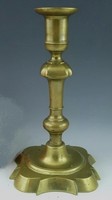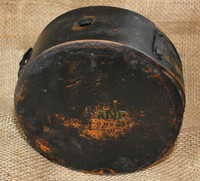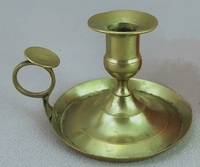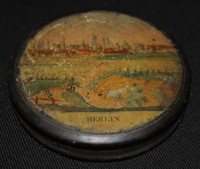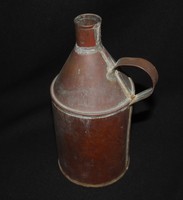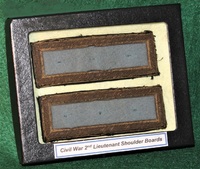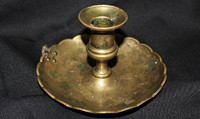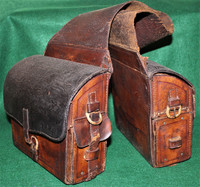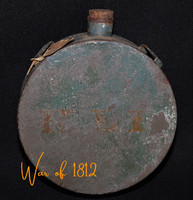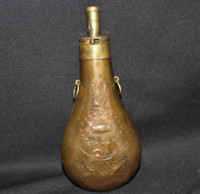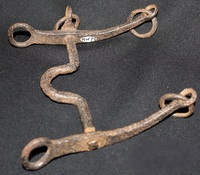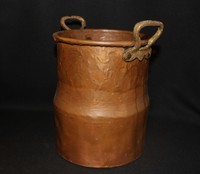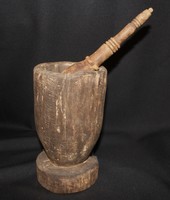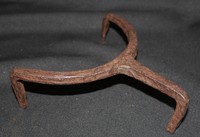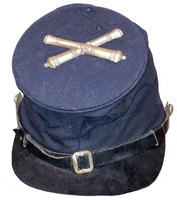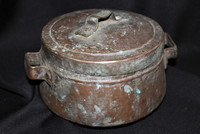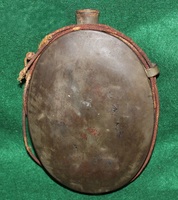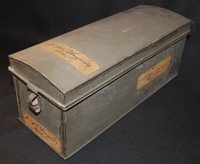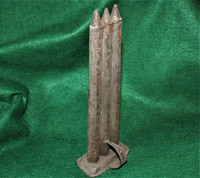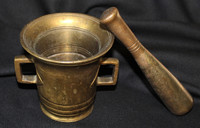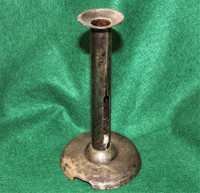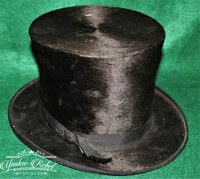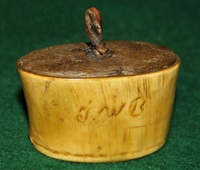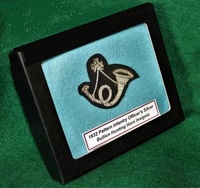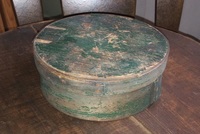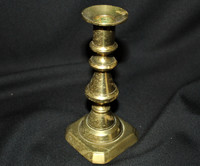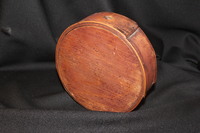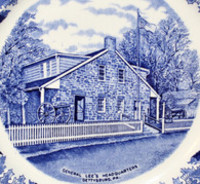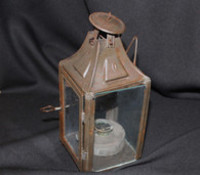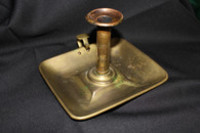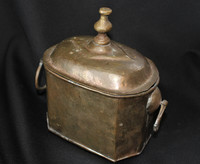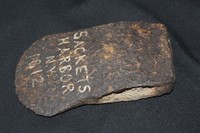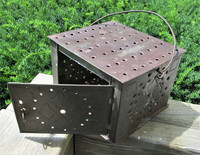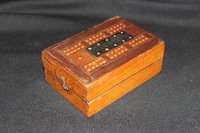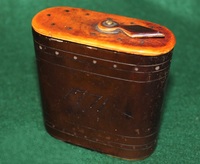Round Top Antiques

Tags
Thanks for your interest in Round Top Antiques. I have been involved with original 18th and 19th century artifacts and memorabilia through buying, collecting, selling, and appraising since 1989. I have always had a fond interest in the Civil War era, collecting and selling. The past few years I have also been involved with earlier objects from the Revolutionary War and the French and Indian War era. Over the years I have written magazine articles and written seven books with Civil War topics. “The Civil War Canteen” was my first published book back in 2007 and then had an updated version available “The Civil War Canteen - Second Edition”. “Battle of Gettysburg - The Relics, Artifacts & Souvenirs” was published in 2008. I also had my first children's book published, “Children at the Battle of Gettysburg - Their Unforgettable Summer”. In 2013 I wrote “Civil War Artillery - A Pictorial Introduction”. In 2014 I released "The Civil War Soldier - His Personal Items" and in 2022 I released the much acclaimed "The Civil War Canteen - Third Edition". Original quality 18th and 19th century artifacts have been increasingly difficult to come by. With many years of dealing with collectors, museums, and people who are just generally interested in history, I have established quite a few resources. This allows me to pass along both the common and rare pieces for your personal collections. Every collector has their own preferences, so I strive to supply a variety of antiques at affordable prices. I will be adding new artifacts every week, so check back regularly. You can always contact me at: Bob33rd@optonline.net Checks, money orders, PayPal, gladly accepted. You can also call me with a credit card number, and I will process it over the phone (973) 810-2976 (if no answer, leave a brief message and I will get back to you soon). Please drop me an email at Bob33rd@optonline.net and I will let you know the availability of an item, the shipping charges, and details for paying. (U.S. Army combat veteran - owned and operated) (Member of Gettysburg Battlefield Preservation Association) (Member Gettysburg Foundation) (Member The Army Historical Foundation) (Member American Battlefield Trust)
This early candle stick has a scalloped base, seamed baluster plinth with notched umbrella. Lovely color and patina. Exceptional early stick. It measures 7 1/4" high and 4" wide at the base. There is a very slight seam separation on candle cup - not through, but just on the surface, notwithstanding, excellent clean condition and solid.
Price: $120.00
This is another great piece being offered, it is an 18th century wooden “Cheesebox” Revolutionary War Canteen, c.1760 – 1790. It measures 5 ¼” x 2 ½” and the side panel overlaps with a single broad “tongue”. It has the original black milk base paint with the three original leather strap guides, iron tacks and wooden pegs. What makes this example rare and unique is the owner’s name “LANE” is nicely branded on one side. The term “Cheesebox” is NOT a period term, but one added over the years because of its appearance. This unique canteen is a real beauty, I acquired it after my book was published, otherwise iI would have included it. It is in very nice condition and has a gorgeous untouched patina.
Price: $585.00
Being offered is a Diminutive Brass Chamberstick with Finger holder circa 1740-1760. It has a 4” diameter x 3 1/4” tall. It has the earlier cast piece with riveted finger holder, and a threaded removable base for traveling. There are examples of this piece in “Early American Antique Country Furnishing”, by George Neumann. He states this is a 1740 piece. As with everything else in his lifetime collection, this is a beautiful and rare. ex-Roger Speth piece. (SOLD)
Price: 85.00 SOLD
The box is circa 1810 -1840 and measures 3 1/2" x 1/2". It appears to be hand-painted with the word "BERLIN" and an early view of the city. It is in very nice condition.
Price: 85.00 SOLD
It measures 8 1/2" high and has a 4" diameter on the bottom. The seams are soldered, which is correct for the period, along with a flat bottom. It remains in very nice untouched condition.
Price: $45.00
This is a beautiful matching pair of original Infantry 2nd Lieutenant's Civil War officer shoulder boards. These are for the rank of 2nd Lieutenant because being void of any bars within the bullion border. To indicate the infantry branch of service, there is the light blue color. This version with the single border is the typical Civil War design and size. Civil War officers were not issued uniforms or equipment like the enlisted man would receive. He had to pay out of his own pocket for his uniform, sword, kepi, accoutrements, etc. There were many dealers who had establishments and put out catalogs of their wares, such as Horstmann. Officers were not as regulated as enlisted men with what they wore and their adornments and insignia. This was left up to the officer as to how much he was willing to spend and his particular taste. The boards are in fine, complete condition with the normal wear from use during the war, not an unused pair from surplus stock. The blue color is beautiful and has very little fading. Each board measures 4 inches by 1 1/2 inches in overall size.
Price: $425.00
This is late 18th century – early 19th century heavy brass, collapsible candle holder. It stands 3 1/2” high with a diameter of 5” at the scalloped base. It appears to have had a finger ring at one time, but this is long gone, to a point where it is actually smooth now. It easily unscrews for travel. It shows signs of extended use and has a great untouched patina finish. In my book “The Civil War Soldier – His Personal Items”, I go into detail about the use of candles and candlesticks, and just how important they were for every soldiers during the Civil War. Being that such items were not issued to Civil War officers, this would be typical of what they brought with them from home. It is made of solid brass and heavy for a candle holder. Being collapsible, it was ideal when on the move. It would make a great addition to just about any collection.
Price: $125.00
Civil War Surgeon’s saddle bags. Each measures approximately 8 ¼” x 7 ½” x 3”. On the sides of the bags are drawers which pull out and would have contained vials of medicines. In good condition with intact drawers for medicines. Dividers are present inside for apothecaries. Leather is supple and has bone closure buckles. In "Pictorial Encyclopedia of Civil War Medical Instruments & Equipment" by Doctor Dammann, there is a very similar example of these bags. Medical saddle bags were carried by surgeons in the field to hold a variety of medicines for the treatment of the sick and wounded. There was a lack of qualified doctors during the Civil War, so it was necessary for them to move around, usually within the battalion. The saddle bags were designed to carry smaller quantities than apothecary chests, making it easier for the surgeons to move about. Most museums have examples, such as the National Civil War Museum and the Civil War Medical Museum. Seldom do these bags hit the open market, they are relatively rare with a low survival rate. These were well used but are still in nice condition. There are a couple pieces of small leather that came off over the years and are inside. SOLD
Price: $000.00
Measures 5 ½” x 2” and originally it was painted green and in gold lettering is “K L I”. It has three sling keepers and the cork. Misidentified tag stating “Civil / War / Round / Ca….”.(Possibility it could have been used during the Civil War). Established around 1807, the Keene Light Infantry (KLI) was an independent infantry company organized and operated by a group of men in Keene, New Hampshire. During the War of 1812, the state of New Hampshire was called upon to furnish 3500 men to fill the ranks of the militia. The Keene Light Infantry unit quickly responded and was one of those units that helped fill the state requirement. The organization functioned as part of the state militia, but also served as an honor guard, escorting dignitaries during processions and celebrations, and as a social organization. At the beginning of the Civil War, the Militia was virtually nonexistent. The state had to raise volunteer regiments, such as the 6th New Hampshire Volunteer Infantry, to aid in the war. In my book “The Civil War Canteen – Third Edition”, I show one of these New Hampshire War of 1812 canteens (see pictures). These Keene canteens are rare and is the first I came across. SOLD
Price: $485.00
U.S .Brass “Peace Flask”, measuring 9 ¼” x 4 ¼”. The design consists of a spread-winged eagle above a circle of 26 five-pointed stars. In the center of the circle are a pair of shaking hands within a sunburst. Below the circle of stars is a US shield at the center of a panoply of flags with crossed cannons and a Corinthian helmet. This design is found on both sides of the flask. The adjustable brass spout and cap are also in good condition. I didn’t try it, but the spout can probably be adjusted to the three settings, and I am sure the cap can still be unscrewed. The top of the cap is stamped with a maker’s mark and date that reads “N. P. AMES” and the date “1838”.” On the side of the cap is a small lever for opening the horn to dispense powder into the spout or measurer. Attached to each side of the flask just below the neck are two triangular sling keepers. This Peace Flask is about as nice as they come, complete with tight seams and the original untouched patina. In the Gettysburg NPS Museum, there is an identical example of this flask. (SOLD)
Price: 485.00 (SOLD)
This is another interesting piece being offered, it is an iron horse bit, which is pre-war and probably seen Confederate use. It measures 7” x 8”. There are very similar bits in “Horse Equipment of the Civil War Era”, by Howard Crouch. He states those were found in early Confederate Artillery camps in Virginia. It is not rusted in place; all of the parts and rings still move and no chipping or flaking. It would be a nice addition to a Cavalry, or Civil War collection.
Price: $125.00
This is an amazing hand-hammered large Antique Copper Pot, circa 1750 – 1810. It has a diameter of 7 ¼” at the top, 7” on the bottom, and about 9” high. It has dovetail joint/cramp seams running the length of one side, as well as around and across the base. It also has two brass handles on the top. The dovetail/cramp joint cuts are irregular, large, and widely spaced, characteristic of 1700s construction (as simple straight seams did not begin to replace dovetail/cramp construction until the 1800s). This method was insanely hard to do. Not only was the cutting very difficult, but also matching the copper together and then braising it to essentially melt the copper together was incredibly painstaking. It’s one of the reasons they are rare – they were harder and more expensive to make so large quantities weren’t made. They are beautiful…but tricky!
Price: $485.00
This is a fantastic looking, very old Mortar and Pestle, circa 1740s – 1780s. The overall height of the mortar is 8 ½” with a diameter of 5” and the pestle is 9” x 1 ¾”. Both pieces are made from one piece of wood. A mortar and pestle is a set of two simple tools used to prepare ingredients or substances by crushing and grinding them into a fine paste or powder in the kitchen, laboratory, and pharmacy. It is still a solid piece but does show its age with cracks and a piece broken off at the base. (Please see photos for condition). There is a very good chance that this piece could have been used during the Revolutionary War. There is a near identical example of one in the Revolutionary War Fort Ticonderoga Museum. There is also one pictured in “Collector’s Illustrated Encyclopedia of the American Revolution”, by Neumann and Kravic.
Price: $245.00
Though commonly referred to as a "Pot" or "Kettle" pusher, a piece such as this actually served several functions in an open hearth fireplace. The primary purpose was to have the hearth attendee use the article to push and maneuver various cooking vessels around the front of an open hearth fireplace. It is blacksmith-made and measures 7” x 7” x 1 ¾” high. The second was to have the piece push embers and coals out of the hearth to use with broilers and other cooking utensils. If you have ever been to Colonial Williamsburg, you can see reenactors using coal pushers to arrange hot coals under broilers. It's a common misconception that cooking utensils were inserted directly into the fireplace, many and most rested outside the direct heat and utilized the more controlled temperature. Examples can be seen illustrated in George Neumann’s landmark volume "Early American Antique Country Furnishings". This piece is most probably of New England origin but could have possibly been brought over by English immigrants as well. Simply a superb piece of early American hearth ware.
Price: $185.00
Original Civil War Union Enlisted Man’s Forage Cap with Artillery Insignia. It is an early war Type I cap, exhibiting fine, deep blue color, with only a slight bit of insect/moth damage. The chinstrap, retaining its sheet brass adjuster buckle, is affixed to the cap by two, general service, eagle buttons, which is correct for this kepi. The interior of the cap exhibits a complete, polished, brown cotton lining; the leather sweat band is complete and in overall good condition. On top of the crown is an original, enlisted man’s, crossed cannons, artillery insignia, which is original to the cap. On the interior of the crown, a partial, original, U.S. Army size label remains. This is a fine example of a Union enlisted man’s forage cap and would make a great center piece for any Civil War collection. Original Civil War head gear is extremely hard to find, especially in this condition. (ON HOLD)
Price: $3100.00
This is a very early hammered copper pot, circa 1780 – 1820. With the lid on it measures 5” high and the diameter to the ends of the handles is 9”. It is complete with a lid that has a crudely attached handle and the body of the pot also has handles. This style was known as copper cooking trade pans. The brass handles are peened with rivets. It has the original blue-green patina and has never been cleaned, which is rare today, however, it would also look very nice cleaned up.
Price: $85.00
Out of the 60-year Revolutionary War collection I am working on. It is an Oval Tin Canteen, circa 1740 – 1760. It measures 7 ½” x 5 ¾” x 1 ½” and has three rounded sling loops and all seams are soldered. It also has a carrying cord which appears to be original to the canteen. I found an identical example of this canteen that states “Captured at Yorktown, Va.” It has the same measurement, but at one time a Civil War era cork and chain was added (probably by a modern day collector for display). There were both Revolutionary War battles and Civil War battles at Yorktown. Examining the canteen, the style, and manufacturing, it dates more to the Revolutionary War. Being tagged with “Captured”, I would say it was the Cornwallis surrender, not taken from a Confederate soldier. I discuss early canteens through the Civil War and Reunion canteens in my book "The Civil War Canteen - Third Edition". SOLD
Price: $000.00
This is a very unique piece being offered, it is circa late 18th – early 19th century document box. It measures 13” x 5” x 4 3/4”, has the period correct soldered seams, and a hinged lid. It was found in an antebellum house in Philadelphia, PA. In several areas on the box in old brown ink is “Joseph Smyser’s Box”. These boxes were the forerunners for today’s bank Safety Deposit Boxes. They would keep important documents, money, jewelry, and other valuables. This box is in very nice condition with no issues, only showing the normal signs for its age.
Price: $145.00
This is a tin Colonial era 3-barrel candle mold for making tapered candles. The size is 4” x 3 ½” x 10 ½” high. It has a soldered side handle as well as the other seams. There is an example of this mold in “Early American Antique Country Furnishings”, by George Neumann, he has this style as circa 1750 - 1850.
Price: $75.00
This is a heavy cast and turned bronze mortar and pestle dating from the early 19th century through mid-1800s. The diameter on the top is 4 ¼” and 3” diameter on the bottom. The overall height is 4 ½” and weights almost five pounds. It even has the faint file marks on it from final finishing. This is not one of the often encountered later examples, or the common Chinese castings. This type would have been used by military surgeons throughout the Civil War. Most medicines of the time were in a bulk form and would have to be crushed and mixed, and these mortar and pestles would be a necessity. It was also typical in most early households. The rare19th century bronze apothecary mortar & pestle retains its original patina and would make a nice addition to any quality medical grouping or will go well simply as a period decorative piece.
Price: $145.00
This is another great piece being offered, it is an early to mid-19th century candle holder, hand-forged of heavy sheet iron. It stands 7 ¼” high with a diameter of 4” at the base. At one time there would be a sliding push-up mechanism to raise and lower the candle, but after many years of hard use, it has fallen off – common with these candle sticks. It has a nice aged untouched patina finish. During the early 19th century most households had several of these candle holders available. In my book “The Civil War Soldier – His Personal Items”, I go into detail about the use of candles and candlesticks, and just how important it was for every soldier.
Price: $55.00
Being offered is an early to mid-19th century top hat. The exterior is polished silk with a black satin ribbon; the interior has a silk and calf leather, hand-sewed lining. The hat stands 6” high, the diameter at the top is 8” x 7 ¾”, the opening is 6 ½” x 7 ¾”, and the overall width is 12 12” x 11”. Stamped in the interior is “Harris & Co. / Opp Post Office Portland”. Below is the name of the famous maker “MELTON / HATTER / TO THE / QUEEN / TO H.R.H. THE / PRINCE OF WALES / AND / NAPOLEON / THE THIRD”. Below is “194 REGENT STREET / LONDON”. Henry Melton was considered the best manufacturer of hats in England, called “Prince of Hatters”. This hat is in very nice condition, retaining its original shape. There are a few blemish spots on the hat, but nothing serious, only from typical use. The stamp with “Harris & Co.” was probably an independent seller of Melton’s hats. This particular hat was made prior to the Civil War – later hats had an additional marking above their usual stamp “PRIZE MEDAL PARIS EXHIBITION 1867” (not on this earlier hat). This is a fantastic piece and would be hard to find a nicer example.
Price: $445.00
It has a nice set of initials carved into the side of the horn, and a removable wooden lid with leather tab. It measures 2 ¾” wide x 1 ½” deep x 2 ½” high. The initials appear to be “T W B”. They are usually identified as snuff boxes, though they served a number of purposes. Some contained a flint, steel, and tinder (wood shavings or mashed pine cone). See Collector’s Illustrated Encyclopedia of the Revolutionary War, Neumann, p.246 #1 for an example identified as a snuff box. Throughout the 18th and 19th centuries snuff production boomed, far outstripping smoking tobacco (or its US sibling, chewing tobacco). And it was even recommended by doctors as a general cure-all, particularly effective in the treatment of coughs, colds, and headaches. Many Revolutionary War soldiers (both American and British) carried snuff in their haversacks in containers such as this one, they would wrap it in a handkerchief or sock. (SOLD)
Price: $000.00
This is an original 1832 Pattern Infantry Officer’s Silver Bullion Hunting Horn Insignia. It measures approximately 2 ¾” x 2” with a black background and silver bullion and sequins. The1832 pattern embroidered hunting horn was authorized for the tails of infantry officers’ coats, replacing the old blue-cloth diamonds. Militia followed the trend, with greater or lesser strictness. These remained regulation in the regular army until 1851 and much later in militia units and into the Civil War. These were of an earlier style with the horn dangling from a tassel that was likely inspired by British light infantry units and identical to the one used by the British Oxfordshire and Buckinghamshire Light Infantry Regiment. The same design was used as an officer’s skirt-tail ornament on the back of the tailed coats worn prior to the introduction of the frock coat. The same open bugle horn, sometimes called the stringed horn, appeared as a cap ornament on the regular army shako from 1832 to 1851, with some made of white metal. It is possible, however, that an embroidered device like this may well have made its way onto militia headgear. I have seen many of these priced over $300.00.
Price: $175.00
You just don’t see these boxes very often, still having much of the original green paint. It measures 6 ½” by 2 ½” tall and a great example of a primitive pantry box, just having the typical signs of its age. Just a super attic fresh box all original and in nice condition.
Price: $165.00
This is a mid-19th century brass push-up candle holder. It stands 6 1/2” high x 3” at the base. In “Lighting Devices and Accessories” by Stan Hamper, this one is described as a brass “Bee Hive Candlestick, 19th c.”. At the bottom of the candlestick is a circular disc that you push to raise and lower the candle. In my book “The Civil War Soldier – His Personal Items”, I go into detail about the use of candles and candlesticks, and just how important they were for every soldier. Being that such items were not issued to Civil War officers, this would be typical of what they brought with them from home.
Price: $75.00
This is another great early canteen being offered. It is a “Cheesebox” style canteen, possibly maple, with a diameter of 7” and 2” wide. It has an old faded red surface. The term “Cheesebox” is NOT a period term, but one added over the years because of its appearance. This style of Three Piece Wood Canteen was used by American troops from the 2nd half of the 18th Century to the first half of the 19th Century. They are often referred to as War of 1812 canteens, but that is not always the case. I show three Cheesebox canteens which were dated and identified to soldiers in the Revolutionary War. There are even examples that were brought from home by soldiers in the Civil War. Although extant canteens with a given provenance suggest that this style of Canteen was used primarily by troops from the Northern Colonies, particularly New England, but their use by other troops cannot be definitively ruled out. Also, in my book “The Civil War Canteen – Third Edition”, I show some of these canteens. It is in nice condition, only showing the signs expected for its age.
Price: 385.00 SOLD
This is a beautiful 9 ¾” collector’s plate featuring Lee’s Headquarters Museum in Gettysburg. The front shows the house with “General Lee’s Headquarters, Gettysburg Pa”. The reverse has “Old English Staffordshire ware, ADAMS, Estd. 1657, England” and “Imported for E.F. Larson, Lee Museum, Gettysburg, PA”. On July 1, 1863, General Robert E. Lee established his personal headquarters in this house. In the Spring of 1922, the house was opened to the public as the Lee Museum by Mr. C.F. Caley, who began displaying artifacts and relics found on the battlefield, brought back to town by visiting veterans, or purchased from local collections and estates. In 1945, Daley sold the museum and adjoining property to Mr. Eric Larson. The museum remained virtually unchanged while in Mr. Larson’s possession until 1995, when it was sold to new owners. The Civil War Trust acquired the property in January 2015, and it was restored to its original appearance, but no longer a museum. In my book “Battle of Gettysburg – The Relics, Artifacts & Souvenirs”, I discuss the museum and show artifacts from the museum as well as a similar plate. It is a gorgeous plate and in excellent condition. SOLD
Price: 55.00 SOLD
This is another nice being offered, it is a tin lantern measuring 8 ½” high x 3” wide, circa 1845 - 1865. The door opens with a crude wire lock and the inside has a round container with wick on the bottom. The fuel used with this would probably be whale oil or kerosene. There is some overall surface rust, but no where rusted through. As with most of these early lanterns, some of the glass has been replaced. SOLD
Price: $000.00
This is a nice early candle holder being offered. It is solid brass and measures 7 ¼” x 6 ½” x 5” high, circa 1780 – 1800. At one time there would have been a small adjusting lever on the side of the tube, but like with many of these older examples, it is now gone. The finger ring may have had something else attached to it. Overall, this is a nice solid piece and would fit in nicely with just about any collection.
Price: $125.00
This is another nice piece being offered, it is a Revolutionary War era tobacco box, circa 1780. It is made of copper/brass and measures 7” wide by 4” deep and 7” high to the top of the finial. It has a hinged lid and two circular handles on the sides. Four ball feet are formed into the base of the container. There are similar examples of this tin in “Early American Antique Country Furnishings”, by George Neumann, and "The Revolutionary War Museum" in Yorktown, Virginia. Tobacco cultivation and exports formed an essential component of the American colonial economy. During the Civil War, they were distinct from other cash crops in terms of agricultural demands, trade, slave labor, and plantation culture. Many influential American revolutionaries, including Thomas Jefferson and George Washington, owned tobacco plantations, and were financially devastated by debt to British tobacco merchants shortly before the American Revolution. This tin is in very nice condition with a tight hinge and snug fitting lid. It also has a beautiful untouched original patina.
Price: 135.00 (SOLD)
This is another nice early piece coming out of a 60-year collection of French & Indian War/Revolutionary War, and War of 1812 artifacts. Being offered is a very early excavated axe head. It measures 7” x 4 ½” x 1 1/8”. These axes were a necessity, especially in thick wooded areas. With artillery, there had to be an open area to get caissons and cannons through and a clearing for firing. In “Soldiers of the American Revolution” by Don Troiani, there is a picture of one of this style axe. It was recovered many years ago from Sackets Harbor, New York. Though the Crown Forces could not win a decisive battle at Sackets Harbor, neither could the U.S. fleet gain control of Lake Ontario early that summer in their effort to conquer Upper Canada. SOLD
Price: 000.00 SOLD
This is another interesting piece being offered, it is a very early tin “Foot Warmer”, circa 1820s – 1850s. It is made of sheet-tin and measures 7” x 6 ½” x 5” high with a bail wire carrying handle. The sides, front door and top have been meticulously hand-punched and decorated. During the 18th and 19th centuries, these foot warmers were a necessity in a sleigh, wagon or carriage during the winter months of traveling. They were also used in the parlor. Before the carriage trip, one would have to fill a generic tin bowl with hot coals from the fireplace and place it inside the door of the foot warmer. It did not produce a lot of heat but was enough to take the chill out during the ride. This early 19th century piece remains in beautiful condition for its age – not rusted out or dented as many of the surviving examples. The seams are soldered, and you can actually see where some of the solder ran when the tin warmer would get too hot.
Price: $125.00
Civil War soldier's folding Cribbage Board. It measures 5 1/4" x 3 1/4" x 2" in the closed position. When opened "10 1/4" x 3 1/4" x 1". Inside the box has the original paper lining and a few pegs. The tiny hook and eye closure still remains. Cribbage is a game of cards played with the aid of a Cribbage Board. It originated in 17th century England where it is thought to have been invented by a poet. Sir John Suckling is believed to have made an adaptation of an older game called “Noddy” about which next to nothing is known in modern days. Cribbage was popular in the New England states where the pilgrims first brought it over from England. It was also the favorite card game of Mr. and Mrs. Benjamin Franklin. Many Union soldiers from the northern states brought these games along with them or had them sent by their families. There are similar examples of cribbage boards in The Civil War Collectors Encyclopedia, by Francis Lord. I have a near identical example of this box pictured in my book "The Civil War Soldier - His Personal Items". SOLD
Price: $000.00
This is a very rare piece being offered, it is a Revolutionary War personal salt carrier. It stands 3 ¼” high x 3 ½” wide x 1 ¾” deep. It is made of wood and bone with a swivel opening on the top and is dated “1771”. SOLD During the Revolutionary War, North Carolina and other southern colonies had relied largely on salt imported from Great Britain to preserve their meats, flavor their foods, and feed their livestock. It was a vital commodity. Leading up to and the eventual outbreak of hostilities, Great Britain had severed all trade with the fledgling American government, causing fear of a salt shortage. To ensure availability, the Provincial Congress initially set price caps on salt, rationed the existing supply, and offered bounties to encourage its manufacture. Not until April 1776, when the colonial government authorized four men to spend up to 2,000 pounds of public funds to establish a salt works, did work begin. Robert Williams and Richard Blackledge, both began salt works near Beaufort County that spring. Fears of a salt shortage had soldiers hoarding their personal supply. A container of this quality would not be carried by a foot soldier, but rather an officer.
Price: 485.00 (SOLD)
Dig Antiques assumes no responsibility for the items listed for sale on DigAntiques.com. Any transactions as a result of items listed for sale through this Shop is strictly between the Shop and the Buyer. Please read the Dig Antiques Terms of Service for more information.



